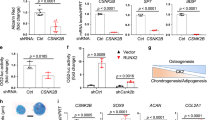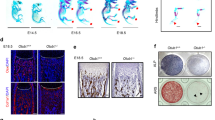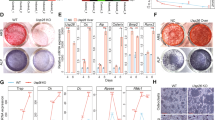Abstract
E3 ubiquitin ligases are final effectors of the enzyme cascade controlling ubiquitylation1. A central issue in understanding their regulation is to decipher mechanisms of their assembly and activity2. In contrast with RING-type E3s, fewer mechanisms are known for regulation of HECT-type E3s2,3,4. Smad ubiquitylation regulatory factor 1 (Smurf1), a C2-WW-HECT-domain E3, is crucial for bone homeostasis, in which it suppresses osteoblast activity5,6. However, whether and how its activity is regulated remains unclear. Here we show that Smurf1, but not Smurf2, interacts with casein kinase-2 interacting protein-1 (CKIP-1), resulting in an increase in its E3 ligase activity. Surprisingly, CKIP-1 targets specifically the linker region between the WW domains of Smurf1, thereby augmenting its affinity for and promoting ubiquitylation of the substrate. Moreover, CKIP-1-deficient mice undergo an age-dependent increase in bone mass as a result of accelerated osteogenesis and decreased Smurf1 activity. These findings provide evidence that the WW domains linker is important in complex assembly and in regulating activity of HECT-type E3s and that CKIP-1 functions as the first auxiliary factor to enhance the activation of Smurf1.
This is a preview of subscription content, access via your institution
Access options
Subscribe to this journal
Receive 12 print issues and online access
$209.00 per year
only $17.42 per issue
Buy this article
- Purchase on Springer Link
- Instant access to full article PDF
Prices may be subject to local taxes which are calculated during checkout





Similar content being viewed by others
Change history
27 April 2010
In the version of this letter initially published online, Fig. 1c, Fig. 3a and Fig. 3c were incorrectly labelled. These errors have been corrected in both the HTML and PDF versions of the letter.
References
Pickart, C. M. Mechanisms underlying ubiquitylation. Annu. Rev. Biochem. 70, 503–533 (2001).
Kee, Y. & Huibregtse, J. M. Regulation of catalytic activities of HECT ubiquitin ligases. Biochem. Biophys. Res. Commun. 354, 329–333 (2007).
Ingham, R. J., Gish, G. & Pawson, T. The Nedd4 family of E3 ubiquitin ligases: functional diversity within a common modular architecture. Oncogene 23, 1972–1984 (2004).
Shearwin-Whyatt, L., Dalton, H. E., Foot, N. & Kumar, S. Regulation of functional diversity within the Nedd4 family by accessory and adaptor proteins. BioEssays 28, 617–628 (2006).
Zhu, H., Kavsak, P., Abdollah, S., Wrana, J. L. & Thomsen, G. H. A SMAD ubiquitin ligase targets the BMP pathway and affects embryonic pattern formation. Nature 400, 687–693 (1999).
Yamashita, M. et al. Ubiquitin ligase Smurf1 controls osteoblast activity and bone homeostasis by targeting MEKK2 for degradation. Cell 121, 101–113 (2005).
Kavsak, P. et al. Smad7 binds to Smurf2 to form an E3 ubiquitin ligase that targets the TGF β receptor for degradation. Mol. Cell 6, 1365–1375 (2000).
Ogunjimi, A. A. et al. Regulation of Smurf2 ubiquitin ligase activity by anchoring the E2 to the HECT domain. Mol. Cell 19, 297–308 (2005).
Gallagher, E., Gao, M., Liu, Y. C. & Karin, M. Activation of the E3 ubiquitin ligase Itch through a phosphorylation-induced conformational change. Proc. Natl Acad. Sci. USA 103, 1717–1722 (2006).
Wiesner, S. et al. Autoinhibition of the HECT-type ubiquitin ligase Smurf2 through its C2 domain. Cell 130, 651–662 (2007).
Barrios-Rodiles, M. et al. High-throughput mapping of a dynamic signaling network in mammalian cells. Science 307, 1621–1625 (2005).
Bosc, D. G. et al. Identification and characterization of CKIP-1, a novel pleckstrin homology domain-containing protein that interacts with protein kinase CK2. J. Biol. Chem. 275, 14295–14306 (2000).
Safi, A. et al. Role for the pleckstrin homology domain-containing protein CKIP-1 in phosphatidylinositol 3-kinase-regulated muscle differentiation. Mol. Cell. Biol. 24, 1245–1255 (2004).
Zhang, L. et al. Role for the pleckstrin homology domain-containing protein CKIP-1 in AP-1 regulation and apoptosis. EMBO J. 24, 766–778 (2005).
Canton, D. A. et al. The pleckstrin homology domain-containing protein CKIP-1 is involved in regulation of cell morphology and the actin cytoskeleton and interaction with actin capping protein. Mol. Cell. Biol. 25, 3519–3534 (2005).
Zhang, L. et al. CKIP-1 recruits nuclear ATM partially to the plasma membrane through interaction with ATM. Cell Signal. 18, 1386–1395 (2006).
Sapkota, G., Alarcon, C., Spagnoli, F. M., Brivanlou, A. H. & Massagué, J. Balancing BMP signaling through integrated inputs into the Smad1 linker. Mol. Cell 25, 441–454 (2007).
Fuentealba, L. C. et al. Integrating patterning signals: Wnt/GSK3 regulates the duration of the BMP/Smad1 signal. Cell 131, 980–993 (2007).
Wang, H. R. et al. Regulation of cell polarity and protrusion formation by targeting RhoA for degradation. Science 302, 1775–1779 (2003).
Ozdamar, B. et al. Regulation of the polarity protein Par6 by TGFβ receptors controls epithelial cell plasticity. Science 307, 1603–1609 (2005).
Sudol, M. & Hunter, T. NeW wrinkles for an old domain. Cell 103, 1001–1004 (2000).
Derynck, R., & Zhang, Y. E. Smad-dependent and Smad-independent pathways in TGF-β family signalling. Nature 425, 577–584 (2003).
Huang, L. et al. Structure of an E6AP-UbcH7 complex: insights into ubiquitination by the E2-E3 enzyme cascade. Science 286, 1321–1326 (1999).
Verdecia, M. A. et al. Conformational flexibility underlies ubiquitin ligation mediated by the WWP1 HECT domain E3 ligase. Mol. Cell 11, 249–259 (2003).
Asanuma, K. et al. Synaptopodin orchestrates actin organization and cell motility via regulation of RhoA signalling. Nature Cell Biol. 8, 485–491 (2006).
Sangadala, S., Boden, S. D., Viggeswarapu, M, Liu, Y. & Titus, L. LIM mineralization protein-1 potentiates bone morphogenetic protein responsiveness via a novel interaction with Smurf1 resulting in decreased ubiquitination of Smads. J. Biol. Chem. 281, 17212–17219 (2006).
Yang, X. et al. ATF4 is a substrate of RSK2 and an essential regulator of osteoblast biology: implication for Coffin–Lowry syndrome. Cell 117, 387–398 (2004).
Jones, D. C. et al. Regulation of adult bone mass by the zinc finger adapter protein Schnurri-3. Science 312, 1223–1227 (2006).
Kenner, L. et al. Mice lacking JunB are osteopenic due to cell-autonomous osteoblast and osteoclast defects. J Cell Biol. 164, 613–623 (2004).
Tan, X. et al. Smad4 is required for maintaining normal murine postnatal bone homeostasis. J. Cell Sci. 120, 2162–2170 (2007).
Acknowledgements
We thank N. Hou and Y. Tie for technical help; D. Chen, C. X. Deng, D. W. Litchfield, M. Liu, K. Miyazono and Y. Xiong for providing materials; and X. F. Wang, X. Guo and C. Lu for helpful advice. This study was supported by Chinese National Basic Research Programs 2006CB910802 (F.H., L.Z.) and 2007CB914601 (L.Z.), Chinese National Natural Science Foundation Projects 30621063 (F.H.) and 30570366 (L.Z.), and Beijing Science and Technology NOVA Program 2007A063 (L.Z.).
Author information
Authors and Affiliations
Contributions
L.Z. and F.H. co-organized and performed project planning, data analysis, discussion and writing; K.L. performed the main experimental work of CKIP-1–Smurf1 interaction, CKIP-1 regulation on Smurf1 activity and molecular mechanism investigations; X. Yin performed the main experimental work of generating CKIP-1 gene knockout mice and bone phenotype analysis; T.W., L.L., X.C. and X. Yang participitated in the establishment of CKIP-1 gene knockout mice; T.W. and X. Yang were also involved in the bone phenotype analysis; S.X. participated in the in vitro GST pull-down and in vitro ubiquitylation assays; and G.X. contributed to the protein interaction studies.
Ethics declarations
Competing interests
The authors declare no competing financial interests.
Supplementary information
Supplementary Information
Supplementary Figures S1, S2, S3, S4 and S5 (PDF 1190 kb)
Rights and permissions
About this article
Cite this article
Lu, K., Yin, X., Weng, T. et al. Targeting WW domains linker of HECT-type ubiquitin ligase Smurf1 for activation by CKIP-1. Nat Cell Biol 10, 994–1002 (2008). https://doi.org/10.1038/ncb1760
Received:
Accepted:
Published:
Issue Date:
DOI: https://doi.org/10.1038/ncb1760
This article is cited by
-
PLEKHO2 inhibits TNFα-induced cell death by suppressing RIPK1 activation
Cell Death & Disease (2021)
-
Adaptors as the regulators of HECT ubiquitin ligases
Cell Death & Differentiation (2021)
-
SMURF1, a promoter of tumor cell progression?
Cancer Gene Therapy (2021)
-
Effects of grafting cell penetrate peptide and RGD on endocytosis and biological effects of Mg-CaPNPs-CKIP-1 siRNA carrier system in vitro
Journal of Central South University (2021)
-
Let-7i-5p functions as a putative osteogenic differentiation promoter by targeting CKIP-1
Cytotechnology (2021)



